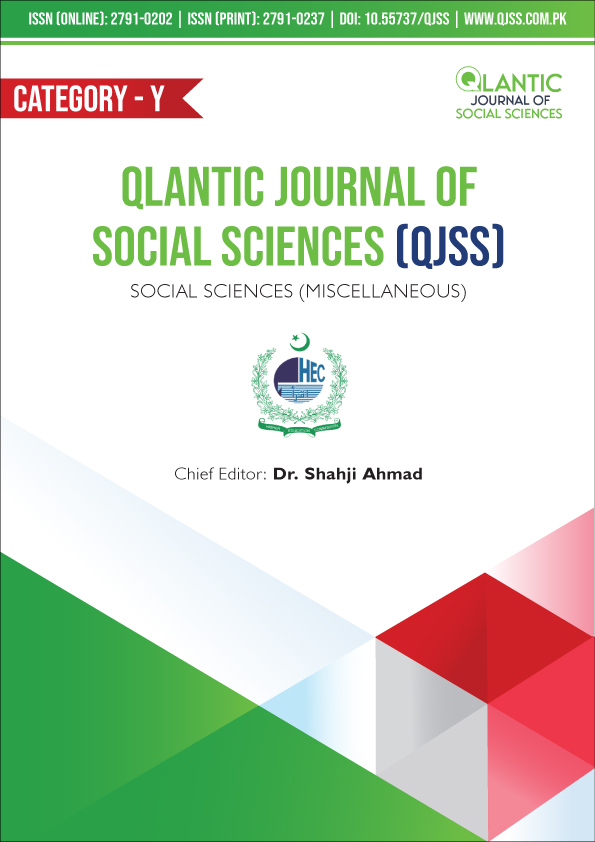Barriers to Inclusivity: Sign Language Interpreters’ Challenges at Higher Education Institutes
DOI:
https://doi.org/10.55737/qjss.vi-i.25310Keywords:
Sign-Language, Hearing Impairment, Inclusivity, Interpreters, ChallengesAbstract
This study examines the challenges faced by the sign language interpreters in fulfilling their role and responsibilities to deal with the students with hearing impairment (SWHI) at higher educational institutions. The research aims to identify the barriers to inclusion for students with hearing impairments in higher education and the role of sign-language interpreters in overcoming these challenges. The study population comprises all sign-language interpreters working at higher education institutions in the district of Lahore. The data was collected from five interpreters of public and private universities using semi-structured interviews. The study finds out that there are several obstacles faced by the interpreters in educating the students with hearing impairments challenged and communication deficient students, such as prevailing unacceptance ratio of fellow teachers and the students and lack of administrative support in this regard at large. It also highlighted the importance of knowledge, dedication, and commitment for sign-language interpreters and the need for institutional support, materials, and methods to guarantee their success.
References
Alzahrani, A. A. (2022). Roles and responsibilities of sign language interpreters in Saudi deaf society. Cogent Education, 9(1). https://doi.org/10.1080/2331186x.2022.2150004
Aniscow, M. (2014). The role of inclusion in creating better education systems. Journal of Education Policy, 29(3). 1-16.
Antia, S. D., & Kreimeyer, K. H. (2001). The role of interpreters in inclusive classrooms. American Annals of the Deaf, 146(4), 355–365. https://doi.org/10.1353/aad.2012.0142
Baron, J., & Kenny, D. A. (1986). The moderator-mediator variable distinction in social psychological research: Conceptual, strategic, and statistical considerations. Journal of Personality and Social Psychology, 51(6), 1173–1182. https://doi.org/10.1037/0022-3514.51.6.1173
Brown, S., & Schick, B. (2011). Interpreting for children: Some important differences. RID Views, 28(4), 22- 25.
Caselli, N. K., Hall, W. C., & Henner, J. (2020). American Sign Language interpreters in public schools: An illusion of inclusion that perpetuates language deprivation. Maternal and Child Health Journal, 24(11), 1323–1329. https://doi.org/10.1007/s10995-020-02975-7
Flores, A. C. da F., & Rumjanek, V. M. (2015). Teaching science to elementary school deaf children in Brazil. Creative Education, 06(20), 2127–2135. https://doi.org/10.4236/ce.2015.620216
Haider, S. Z. (2008). Challenges in higher education: Special reference to Pakistan and South Asian developing countries. Nonpartisan Education Reviews, 4(2), 1–12. https://nonpartisaneducation.org/Review/Essays/v4n2.htm
Hameed, A. (2003). Inclusive schools: an emerging trend in Pakistan. In Proceedings of the International Conference on Inclusive Education: A framework for reforms. Hong Kong.
Humphrey, J. H. (2007). So you want to be an interpreter?: An introduction to sign language interpreting. H & H Publishing Company.
Ibrahim, Z., Alias, N., & Nordin, A. B. (2016). Needs analysis for graphic design learning module based on technology & learning styles of deaf students. Cogent Education, 3(1), 1178364. https://doi.org/10.1080/2331186x.2016.1178364
Kuger, S. (2018). Inclusive education and the education of students with disabilities: A meta-analysis. Review of Educational Research, 88(2), 327–365.
Ladd, P. (2003). Understanding Deaf Culture: In Search of Deafhood. Multilingual Matters.
Laviosa, S., & Davies, M. G. (2020). The Routledge Handbook of Translation and Education. Routledge.
Lee, R. G., & Llewellyn-Jones, P. (2011). Re-Visiting Role: Arguing for a Multi-Dimensional Analysis of Interpreter Behaviour. Supporting Deaf People Online Conference, 9-12th February, 2011.
Maaß, L. M. (2022). Researching relations between hearing Sign Language interpreters and their deaf clients: Methodological considerations on empirical data collection with prelingually Deaf participants. Linguistik online, 118(6), 99-111. https://doi.org/10.13092/lo.118.9106
Ministry of Health (2002). National Policy for Persons with Disabilities, Islamabad Government of Pakistan Ministry of Health, Special Education and Social Welfare.
Mohanty, J. (2000). Current Trends in Higher Education. Deep & Deep Publications.
Mutugi, L. W. (2018). Learning Challenges Faced by Special Needs Education Learners in Public Primary Schools in Mvita Division, Mombasa County, Kenya [Unpublished thesis]. Kenyatta University, Kenya.
Ott, L. E., Hodges, L. C., & LaCourse, W. R. (2020). Supporting deaf students in undergraduate research experiences: Perspectives of American Sign Language interpreters. Journal of Microbiology & Biology Education: JMBE, 21(1), 20. https://doi.org/10.1128/jmbe.v21i1.1943
Rumjanek, V. M., Barral, J., Schiaffino, R. S., Almeida, D., & Pinto-Silva, F. E. (2012). Teaching Science to the Deaf-A Brazilian Experience. In INTED2012 Proceedings (pp. 361-366). IATED.
Slee, R. (2017). Disability, Inclusion and Education. Routledge.
Smith, D. D. (2008). Introduction to Special Education: Teaching in Times of Inclusion (5th ed.). Porto Alegre: Art med.
Smith, M. B. (2013). More than meets the eye: Revealing the complexities of an interpreted education. Gallaudet University Press.
Udoba, H. A. (2014). Challenges faced by teachers when teaching learners with development disability [Unpublished Master’s thesis]. University of Oslo.
United Nations. (2018). Convention on the Rights pf Persons with Disabilities.
World Health Organization (2017). Deafness and Hearing Loss. http://portal.mec.gov.br/seesp/arquivos/pdf/politica.pdf




